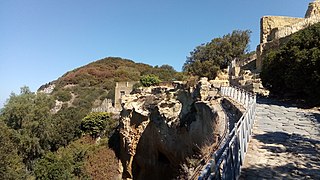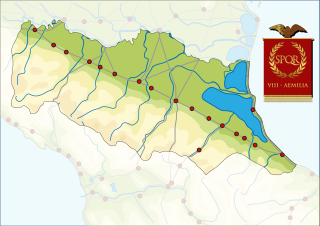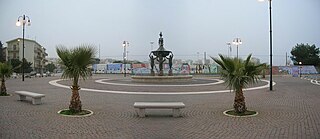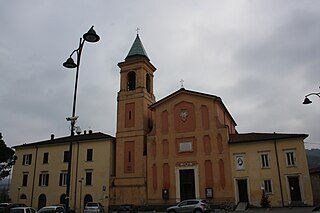
Cumae was the first ancient Greek colony of Magna Graecia on the mainland of Italy, founded by settlers from Euboea in the 8th century BC and soon became one of the strongest colonies. It later became a rich Roman city, the remains of which lie near the modern village of Cuma, a frazione of the comune Bacoli and Pozzuoli in the Metropolitan City of Naples, Campania, Italy.

The Via Aemilia was a trunk Roman road in the north Italian plain, running from Ariminum (Rimini), on the Adriatic coast, to Placentia (Piacenza) on the river Padus (Po). It was completed in 187 BC. The Via Aemilia connected at Rimini with the Via Flaminia, which had been completed 33 years earlier, to Rome.
Atella was an ancient Oscan city of Campania, located 20km directly north of Naples.

Novalja is a town in the north of the island of Pag in the Croatian part of Adriatic Sea. In recent times, Novalja has become famous because of the Zrće Beach.
Aveia was an ancient town of the Vestini and Roman former bishopric, which remains a Latin Catholic titular see.
Ozzano dell'Emilia is an Italian comune in the Metropolitan City of Bologna, in northern Italy.

The Archdiocese of Bologna is a Latin Church ecclesiastical territory or archdiocese of the Catholic Church in Northern Italy. The cathedra is in the cathedral church of San Pietro, Bologna. The current archbishop is Cardinal Matteo Zuppi, who was installed in 2015.

Brescello is a comune (municipality) in the Province of Reggio Emilia in the Italian region Emilia-Romagna, located about 80 kilometres (50 mi) northwest of Bologna and about 25 kilometres (16 mi) northwest of Reggio Emilia. As of 31 December 2016, it had a population of 5,621.

Bagnoregio is a comune (municipality) in the Province of Viterbo in the Italian region of Lazio, located about 90 kilometres (56 mi) northwest of Rome and about 28 kilometres (17 mi) north of Viterbo.
Caudium was the main city of the ancient Caudini tribe in Samnium situated on the Appian Way between Beneventum and Capua, in what is now southern Italy. It was 21 Roman miles from Capua, and 11 from Beneventum. It, or nearby Arpaia, became the seat of an early bishopric, which is now a Latin Catholic titular see.

Siponto was an ancient port town and bishopric of Magna Graecia in Apulia, southern Italy. The town was abandoned after earthquakes in the 13th century; today the area is administered as a frazione of the comune of Manfredonia, in the province of Foggia. Siponto is located around 3 km south of Manfredonia.
San Giovanni Profiamma is a civil parish in the municipality of Foligno in the province of Perugia, which is also an active bishopric, and is the historical site of the former Roman town and bishopric of Foro Flaminii, which remains a Latin Catholic titular see as Foro Flaminio. It is in the circoscrizione no. 6: San Giovanni Profiamma-Belfiore-Vescia-Capodacqua-Pontecentesimo.

The Diocese of Civitavecchia-Tarquinia is a Latin Church ecclesiastical territory or diocese of the Catholic Church in Lazio, Italy. It was established under this name in 1986. The diocese is immediately exempt to the Holy See and not part of an ecclesiastical province.

Passo Corese is an Italian town and hamlet (frazione) of Fara in Sabina, a municipality in the province of Rieti, Lazio. In 2011 it had a population of 3,573.

The Mausoleum of Helena is an ancient building in Rome, Italy, located on the Via Casilina, corresponding to the 3rd mile of the ancient Via Labicana. It was built by the Roman emperor Constantine I between 326 and 330, originally as a tomb for himself, but later assigned to his mother, Helena, who died in 330.

Aquino is a town and comune in the province of Frosinone, in the Lazio region of Italy, 12 kilometres (7 mi) northwest of Cassino.
Civitella d'Arna is a frazione of the comune (municipality) of Perugia in central Italy, and the Ancient city and former bishopric Arna, which remains a Latin Catholic titular see.
The following is a timeline of the history of the city of Bologna, Emilia-Romagna region, Italy.

Modigliana Cathedral, otherwise the Church of Santo Stefano Papa, is a Roman Catholic cathedral and the principal church of Modigliana in Emilia-Romagna, Italy. It is dedicated to the sainted Pope Stephen I. An ancient church, it was made the seat of the bishops of Modigliana on the creation of the diocese in 1850, and from 1986 has been a co-cathedral in the Diocese of Faenza-Modigliana.
The Roman Catholic Diocese of Pesto was a bishopric, later under the name of Capaccio, and became a Latin Catholic titular see in 1966.












